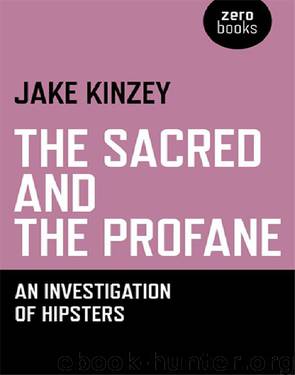The Sacred and the Profane by Jake Kinzey

Author:Jake Kinzey
Language: eng
Format: epub
ISBN: 9781780990354
Publisher: zero books
Chapter Three
Hipsters and ‘‘la passion du réel”
Hipsters are the postmodern subculture and are perfect for a culture that has “revolutionized” itself into stasis. The predominant mood is one of “capitalist realism,” or “the widespread sense that not only is capitalism the only viable political and economic system, but also that it is now impossible even to imagine a coherent alternative to it.” 1 It brings to mind “the phrase attributed to Fredric Jameson and Slavoj Žižek, that it is easier to imagine the end of the world than it is to imagine the end of capitalism.” Perhaps a quick glance at Alain Badiou’s concept of “la passion du réel,” or the passion of the Real, can help in understanding the current cultural impasse.
The passion of the Real (according to Badiou the defining passion of the twentieth century) indicates a tendency for people to strive for authentic, “real” experience and to break up outdated conventions and ways of living. The hipster‘s passion for the Real is expressed in their longing for authenticity, coupled with nostalgic mania, the mad-dash for the real located in a former time. It goes without saying that, from the beginning, the hipster within late capitalism has been largely defined by the utter fetishization of anything “retro.” Consider distressed or worn-out jeans, a trend that arose in Japan, along with other places, in the 1990’s, and has since become a dominant trend in mainstream fashion. Japan, in a more accelerated way then its economic counterparts, was a “plastic” society, where “people were starving for the real thing.” 2 The “‘discovery’ of jeans as antiques required a society that could aestheticize the ordinary.” Japan was just that society: “it’s as if jeans [were] the answer to a society steeped in simulacra.” They began to buy vintage jeans (vintage not just in name; some of these jeans were over one-hundred years old) in large numbers at prices ranging from the low hundreds to thousands of dollars.
One could characterize postmodern “contemporary culture as irredeemably historicist, in the bad sense of an omnipresent and indiscriminate appetite for dead styles and fashions […] for all the styles and fashions of a dead past.” 3 Postmodernity wants to have a relationship with the past, but is part of “a new and original historical situation in which we are condemned to seek History by way of our own pop images and simulacra of that history, which itself remains forever out of reach.” 4 In these times, “the word new doesn’t seem to have the same resonance for us any longer; the word itself is no longer new or pristine.” 5 In (postmodern) capitalist realism “the focus shifts from the Next Big Thing to the last big thing – how long ago did it happen and just how big was it?” 6
The hipster and the postmodern share a “penchant for jumbling together all manner of references to past styles […] Reality, it seems, is being shaped to mimic media images.” 7 An “appetite for dead styles
Download
This site does not store any files on its server. We only index and link to content provided by other sites. Please contact the content providers to delete copyright contents if any and email us, we'll remove relevant links or contents immediately.
| Anthropology | Archaeology |
| Philosophy | Politics & Government |
| Social Sciences | Sociology |
| Women's Studies |
Nudge - Improving Decisions about Health, Wealth, and Happiness by Thaler Sunstein(7261)
iGen by Jean M. Twenge(5168)
The Fire Next Time by James Baldwin(5032)
Adulting by Kelly Williams Brown(4243)
The Hacking of the American Mind by Robert H. Lustig(4098)
The Sports Rules Book by Human Kinetics(4084)
The Ethical Slut by Janet W. Hardy(4042)
Captivate by Vanessa Van Edwards(3733)
Mummy Knew by Lisa James(3526)
In a Sunburned Country by Bill Bryson(3376)
The Worm at the Core by Sheldon Solomon(3328)
Ants Among Elephants by Sujatha Gidla(3282)
Suicide: A Study in Sociology by Emile Durkheim(2908)
The Slow Fix: Solve Problems, Work Smarter, and Live Better In a World Addicted to Speed by Carl Honore(2846)
The 48 laws of power by Robert Greene & Joost Elffers(2818)
Humans of New York by Brandon Stanton(2694)
Handbook of Forensic Sociology and Psychology by Stephen J. Morewitz & Mark L. Goldstein(2606)
The Happy Hooker by Xaviera Hollander(2586)
The Tipping Point by Malcolm Gladwell(2566)
